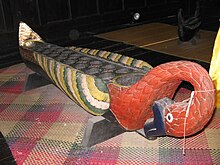



| Part of a series on the |
| Culture of Malaysia |
|---|
 |
| History |
| Topics |
| Symbols |
Traditional Malaysian art is primarily composed of Malay art and Bornean art, is very similar with the other styles from Southeast Asia, such as Bruneian, Indonesian and Singaporean. Art has a long tradition in Malaysia, with Malay art that dating back to the Malay sultanates, has always been influenced by Chinese, Indian and Islamic arts, and also present, due to large population of Chinese and Indian in today's Malaysian demographics.
Colonialism also brought other art forms, such as Portuguese dances and music. During this era, influences from Portuguese, Dutch, and the British, were also visible especially in terms of fashion and architecture in many colonial towns of Malaya and Borneo such as Penang, Malacca, Kuala Lumpur, Kuching and Jesselton. Despite the influences of aboard, the indigenous art of Malaysia continues to survive among the Orang Asli of peninsular and numerous ethnic groups in Sarawak and Sabah.
Nowadays, given the globally influenced and advanced technology, the younger generation of Malaysian artists have moved from the traditional material such as wood, metals, and forest products, and becoming actively involved in different forms of arts, such as animation, photography, painting, sculpture, and street art. Many of them attaining international recognition for their artworks and exhibitions worldwide, combining styles from all over the world with the traditional Malaysian traditions.
